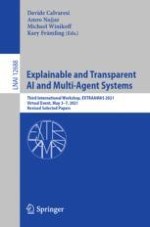2021 | Book
Explainable and Transparent AI and Multi-Agent Systems
Third International Workshop, EXTRAAMAS 2021, Virtual Event, May 3–7, 2021, Revised Selected Papers
Editors: Dr. Davide Calvaresi, Amro Najjar, Prof. Michael Winikoff, Kary Främling
Publisher: Springer International Publishing
Book Series : Lecture Notes in Computer Science
